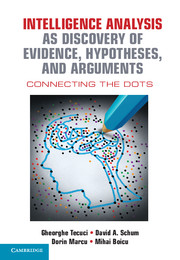Book contents
- Frontmatter
- Contents
- Preface
- Acknowledgments
- About the Authors
- 1 Intelligence Analysis: “Connecting the Dots”
- 2 Marshaling Thoughts and Evidence for Imaginative Analysis
- 3 Disciple-CD: A Cognitive Assistant for Connecting the Dots
- 4 Evidence
- 5 Divide and Conquer: A Necessary Approach to Complex Analysis
- 6 Assessing the Believability of Evidence
- 7 Chains of Custody
- 8 Recurrent Substance-Blind Combinations of Evidence
- 9 Major Sources of Uncertainty in Masses of Evidence
- 10 Assessing and Reporting Uncertainty: Some Alternative Methods
- 11 Analytic Bias
- 12 Learning and Reusing Analytic Expertise: Beyond Disciple-CD
- Glossary of Terms
- References
- Appendixes
- Index
7 - Chains of Custody
Published online by Cambridge University Press: 05 August 2016
- Frontmatter
- Contents
- Preface
- Acknowledgments
- About the Authors
- 1 Intelligence Analysis: “Connecting the Dots”
- 2 Marshaling Thoughts and Evidence for Imaginative Analysis
- 3 Disciple-CD: A Cognitive Assistant for Connecting the Dots
- 4 Evidence
- 5 Divide and Conquer: A Necessary Approach to Complex Analysis
- 6 Assessing the Believability of Evidence
- 7 Chains of Custody
- 8 Recurrent Substance-Blind Combinations of Evidence
- 9 Major Sources of Uncertainty in Masses of Evidence
- 10 Assessing and Reporting Uncertainty: Some Alternative Methods
- 11 Analytic Bias
- 12 Learning and Reusing Analytic Expertise: Beyond Disciple-CD
- Glossary of Terms
- References
- Appendixes
- Index
Summary
WHAT IS A CHAIN OF CUSTODY?
In the previous chapters, we have discussed the different types of evidence (such as testimonial or tangible) and the ingredients of their believability assessment. However, very rarely if ever does the analyst have access to the original evidence. Most often, what is being analyzed is an item of evidence that has undergone a series of transformations through a chain of custody. Here we have borrowed an important concept from the field of law, where a chain of custody refers to the persons or devices having access to the original source evidence, the time at which they had such access, and what they did to the original evidence when they had access to it. The original evidence may be altered in various ways at various links in chains of custody. The important point here is to consider the extent to which what the analyst finally receives is an authentic and complete account of what an original source provided. Uncertainties arising in chains of custody of intelligence evidence are not always taken into account. One result is that analysts are often misled about what the evidence is telling them.
Basically, establishing a chain of custody involves identifying the persons and devices involved in the acquisition, processing, examination, interpretation, and transfer of evidence between the time the evidence is acquired and the time it is provided to intelligence analysts. Lots of things may have been done to evidence in a chain of custody that may have altered the original item of evidence or have provided an inaccurate or incomplete account of it. In some cases, original evidence may have been tampered with in various ways. Unless these difficulties are recognized and possibly overcome, intelligence analysts are at risk of drawing quite erroneous conclusions from the evidence they receive. They are being misled, not by our original sources of evidence, but by the activities of our own persons or devices who do various things to incoming intelligence evidence.
In civilian and military courts, proponents of evidence, for either side of the matter in dispute, are required to verify the chain of custody of tangible evidence before it is admitted to trial. In many cases, evidence gathered is passed from one person to another, each of whom may examine and process the evidence in various ways.
- Type
- Chapter
- Information
- Intelligence Analysis as Discovery of Evidence, Hypotheses, and ArgumentsConnecting the Dots, pp. 139 - 147Publisher: Cambridge University PressPrint publication year: 2016

